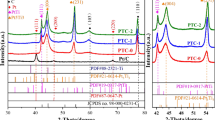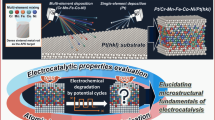Abstract
In continuation of our previous DFT calculations on the possibility of using the earlier transition metal nitrides for catalyzing hydrogen evolution reaction, this work analyzes the (111) facets of these surfaces which are as dominant as the (100) when a polycrystalline catalyst is manufactured. Various hydrogen coverage on these surfaces is considered, the free energy diagram and overpotentials are predicted as well as the kinetics of hydrogen recombination and hydrogen evolution reaction. The outcome of this comprehensive investigation and comparison of activity between the (100) and (111) facets reveal that TaN is the most active surface in both facets with the (100) being more promising with regards to both thermodynamics and kinetics. This study suggests that for optimizing the efficiency in the experiments, surface engineering needs to be considered towards the synthesis of single-crystal structured catalysts rather than utilizing polycrystallines. All the results are also compared with the Pt (111) which is the most active hydrogen evolution catalyst.

taken from ref [25] and is shown with dashed line. The studied (111) surfaces are shown with solid lines


adapted from ref [25]

adapted from ref [25]. In order to reach 2/8 coverage of H on TaN, − 0.45 V needs to be applied and this naturally results in more H coverage, thus some of the points are overlaying at − 0.45 V for TaN

Similar content being viewed by others
Data Availability
The datasets generated during and/or analysed during the current study are available from the corresponding author on reasonable request.
Code Availability
The VASP code was used for the DFT calculations of this manuscript and the corresponding details of that are provided in the manuscript.
References:
Jamesh MI (2016) Recent progress on earth abundant hydrogen evolution reaction and oxygen evolution reaction bifunctional electrocatalyst for overall water splitting in alkaline media. J Power Sources 333:213–236. https://doi.org/10.1016/j.jpowsour.2016.09.161
Turner JA (2004) Sustainable hydrogen production. Science 305(5686):972–974. https://doi.org/10.1126/science.1103197
Zeng K, Zhang D (2010) Recent progress in alkaline water electrolysis for hydrogen production and applications. Prog Energy Combust Sci 36(3):307–326. https://doi.org/10.1016/j.pecs.2009.11.002
Han N, Liu P, Jiang J, Ai L, Shao Z, Liu S (2018) Recent advances in nanostructured metal nitrides for water splitting. J Mater Chem A 6(41):19912–19933. https://doi.org/10.1039/C8TA06529B
Chen WF, Muckerman JT, Fujita E (2013) Recent developments in transition metal carbides and nitrides as hydrogen evolution electrocatalysts. Chem Commun 49(79):8896–8909. https://doi.org/10.1039/c3cc44076a
Xie J, Xie Y (2016) Transition metal nitrides for electrocatalytic energy conversion: opportunities and challenges. Chem—A Eur J 22(11):3588–3598. https://doi.org/10.1002/chem.201501120
Han Y, Yue X, Jin Y, Huang X, Shen PK (2016) Hydrogen evolution reaction in acidic media on single-crystalline titanium nitride nanowires as an efficient non-noble metal electrocatalyst. J Mater Chem A 4(10):3673–3677. https://doi.org/10.1039/c5ta09976e
Chen WF et al (2012) Hydrogen-evolution catalysts based on non-noble metal nickel-molybdenum nitride nanosheets. Angew Chem—Int Ed 51(25):6131–6135. https://doi.org/10.1002/anie.201200699
Cao B, Veith GM, Neuefeind JC, Adzic RR, Khalifah PG (2013) Mixed close-packed cobalt molybdenum nitrides as non-noble metal electrocatalysts for the hydrogen evolution reaction. J Am Chem Soc 135(51):19186–19192. https://doi.org/10.1021/ja4081056
Xie J et al (2014) Atomically-thin molybdenum nitride nanosheets with exposed active surface sites for efficient hydrogen evolution. Chem Sci 5(12):4615–4620. https://doi.org/10.1039/c4sc02019g
Chen Z, Duan X, Wei W, Wang S, Ni B-J (2019) Recent advances in transition metal-based electrocatalysts for alkaline hydrogen evolution. J Mater Chem A 7(25):14971–15005. https://doi.org/10.1039/C9TA03220G
Li C, Baek J-B (2020) Recent advances in noble metal (Pt, Ru, and Ir)-based electrocatalysts for efficient hydrogen evolution reaction. ACS Omega 5(1):31–40. https://doi.org/10.1021/acsomega.9b03550
Liu L, Corma A (2018) Metal catalysts for heterogeneous catalysis: from single atoms to nanoclusters and nanoparticles. Chem Rev 118(10):4981–5079. https://doi.org/10.1021/acs.chemrev.7b00776
Wang M, Zhang L, He Y, Zhu H (2021) Recent advances in transition-metal-sulfide-based bifunctional electrocatalysts for overall water splitting. J Mater Chem A 9(9):5320–5363. https://doi.org/10.1039/D0TA12152E
Callejas JF, Read CG, Roske CW, Lewis NS, Schaak RE (2016) Synthesis, characterization, and properties of metal phosphide catalysts for the hydrogen-evolution reaction. Chem Mater 28(17):6017–6044. https://doi.org/10.1021/acs.chemmater.6b02148
Peng X, Pi C, Zhang X, Li S, Huo K, Chu PK (2019) Recent progress of transition metal nitrides for efficient electrocatalytic water splitting. Sustain Energy Fuels 3(2):366–381. https://doi.org/10.1039/C8SE00525G
Fakioǧlu E, Yürüm Y, Veziroǧlu TN (2004) A review of hydrogen storage systems based on boron and its compounds. Int J Hydrogen Energy 29(13):1371–1376. https://doi.org/10.1016/j.ijhydene.2003.12.010
Wang T-W, Wang T-L, Chou W-J, Wu L-F, Lin S-H (2021) First-principles investigation of the hydrogen evolution reaction of transition metal phosphides CrP, MnP, FeP, CoP, and NiP. Phys Chem Chem Phys 23(3):2305–2312. https://doi.org/10.1039/D0CP04789A
Yu G-Q et al (2021) The combined role of faceting and heteroatom doping for hydrogen evolution on a WC electrocatalyst in aqueous solution: a density functional theory study. J Phys Chem C 125(8):4602–4613. https://doi.org/10.1021/acs.jpcc.0c11104
Pandey DK, Kagdada HL, Materny A, Singh DK (2021) Hybrid structure of ionic liquid and TiO2 nanoclusters for efficient hydrogen evolution reaction. J Phys Chem A 125(12):2653–2665. https://doi.org/10.1021/acs.jpca.0c10912
Zhang B, Fu X, Song L, Wu X (2020) Surface selectivity of Ni3S2 toward hydrogen evolution reaction: a first-principles study. Phys Chem Chem Phys 22(44):25685–25694. https://doi.org/10.1039/D0CP03845H
Abghoui Y, Garden AL, Hlynsson VF, Björgvinsdóttir S, Ólafsdóttir H, Skúlason E (2015) Enabling electrochemical reduction of nitrogen to ammonia at ambient conditions through rational catalyst design. Phys Chem Chem Phys 17(7):4909–4918. https://doi.org/10.1039/C4CP04838E
Abghoui Y, Garden AL, Howalt JG, Vegge T, Skúlason E (2016) Electroreduction of N2to ammonia at ambient conditions on mononitrides of Zr, Nb, Cr, and V: A DFT guide for experiments. ACS Catal 6(2):635–646. https://doi.org/10.1021/acscatal.5b01918
Abghoui Y, Skúlason E (2017) Hydrogen evolution reaction catalyzed by transition-metal nitrides. J Phys Chem C 121(43):24036–24045. https://doi.org/10.1021/acs.jpcc.7b06811
Skúlason E et al (2010) Modeling the electrochemical hydrogen oxidation and evolution reactions on the basis of density functional theory calculations. J Phys Chem C 114(50):22374–22374. https://doi.org/10.1021/jp110913n
Nørskov JK et al (2004) Origin of the overpotential for oxygen reduction at a fuel-cell cathode. J Phys Chem B 108(46):17886–17892. https://doi.org/10.1021/jp047349j
Benck JD, Hellstern TR, Kibsgaard J, Chakthranont P, Jaramillo TF (2014) Catalyzing the hydrogen evolution reaction (HER) with molybdenum sulfide nanomaterials. ACS Catal 4(11):3957–3971. https://doi.org/10.1021/cs500923c
Kibsgaard J et al (2015) Designing an improved transition metal phosphide catalyst for hydrogen evolution using experimental and theoretical trends. Energy Environ Sci 8(10):3022–3029. https://doi.org/10.1039/c5ee02179k
Jaramillo TF, Nørskov JK, Varley J, Grabow L, Kuhl K (2010) “The oxidation of water and the reduction of CO2 to fuels,” pp. 1–16. https://gcep.stanford.edu/pdfs/PE5v0XtfTasff29ZflqL4Q/2.7.2_Jaramillo_Public_Version_2012.pdf. Accessed 29 May 2021
Nitopi S et al (2019) Progress and perspectives of electrochemical CO2 reduction on copper in aqueous electrolyte. Chem Rev 119(12):7610–7672. https://doi.org/10.1021/acs.chemrev.8b00705
McEnaney JM et al (2017) Ammonia synthesis from N 2 and H 2 O using a lithium cycling electrification strategy at atmospheric pressure. Energy Environ Sci 10(7):1621–1630. https://doi.org/10.1128/IAI.73.7.3896-3902.2005
Greeley J et al (2009) Alloys of platinum and early transition metals as oxygen reduction electrocatalysts. Nat Chem 1(7):552–556. https://doi.org/10.1038/nchem.367
Abghoui Y, Skúlason E (2017) Onset potentials for different reaction mechanisms of nitrogen activation to ammonia on transition metal nitride electro-catalysts. Catal Today 286:69–77. https://doi.org/10.1016/j.cattod.2016.11.047
Abghoui Y, Skúlason E (2017) Electrochemical synthesis of ammonia via Mars-van Krevelen mechanism on the (111) facets of group III–VII transition metal mononitrides. Catal Today 286:78–84. https://doi.org/10.1016/j.cattod.2016.06.009
Kresse G, Furthmüller J (1996) Efficiency of ab-initio total energy calculations for metals and semiconductors using a plane-wave basis set. Comput Mater Sci 6(1):15–50. https://doi.org/10.1016/0927-0256(96)00008-0
Hammer B, Hansen LB, Nørskov JK (1999) Improved adsorption energetics within density-functional theory using revised Perdew-Burke-Ernzerhof functionals. Phys Rev B 59(11):7413–7421. https://doi.org/10.1103/PhysRevB.59.7413
Blöchl PE (1994) Projector augmented-wave method. Phys Rev B 50(24):17953–17979. https://doi.org/10.1103/PhysRevB.50.17953
Henkelman G, Jónsson H (2000) Improved tangent estimate in the nudged elastic band method for finding minimum energy paths and saddle points. J Chem Phys 113(22):9978–9985. https://doi.org/10.1063/1.1323224
Markovic N (2002) Surface science studies of model fuel cell electrocatalysts. Surf Sci Rep 45(4–6):117–229. https://doi.org/10.1016/S0167-5729(01)00022-X
Skúlason E et al (2007) Density functional theory calculations for the hydrogen evolution reaction in an electrochemical double layer on the Pt(111) electrode. Phys Chem Chem Phys 9(25):3241–3250. https://doi.org/10.1039/b700099e
Karlberg GS, Jaramillo TF, Skúlason E, Rossmeisl J, Bligaard T, Nørskov JK (2007) Cyclic voltammograms for H on Pt(111) and Pt(100) from first principles. Phys Rev Lett 99(12):126101. https://doi.org/10.1103/PhysRevLett.99.126101
Gohda Y, Schnur S, Groß A (2008) Influence of water on elementary reaction steps in electrocatalysis. Faraday Discuss 140:233–244. https://doi.org/10.1039/b802270d
Abghoui Y (2017) Novel electrocatalysts for sustainable ammonia production at ambient conditions. University of Iceland, Reykjavik
Garden AL, Abghoui Y, Skúlason E (2018) Applications of transition metal nitrides as electrocatalysts. In: Justin SL, Hargreaves SJ, McFarlane AR (eds) Alternative catalytic materials: carbides nitrides, phosphides and amorphous boron alloys. Royal society of chemistry, Cambridge, pp 133–163
Nørskov JK et al (2005) Trends in the exchange current for hydrogen evolution. J Electrochem Soc 152(3):J23. https://doi.org/10.1149/1.1856988
Xiao M, Luo B, Lyu M, Wang S, Wang L (2018) Single-crystalline nanomesh tantalum nitride photocatalyst with improved hydrogen-evolving performance. Adv Energy Mater 8(1):1701605. https://doi.org/10.1002/aenm.201701605
Zhang F, Xi S, Lin G, Hu X, Lou XWD, Xie K (2019) Metallic porous iron nitride and tantalum nitride single crystals with enhanced electrocatalysis performance. Adv Mater 31(7):1806552. https://doi.org/10.1002/adma.201806552
Gillan EG, Kaner RB (1994) Rapid solid-state synthesis of refractory nitrides. Inorg Chem 33(25):5693–5700. https://doi.org/10.1021/ic00103a015
Acknowledgements
Financial support is acknowledged from the Icelandic Research Fund grant numbers 185051051-3, 207056-051, 207056-052, and the Research Fund of the University of Iceland. The calculations were carried out on the Icelandic high-performance computer, Garpur.
Funding
Icelandic research Fund grant numbers 185051051-3, 207056-051, 207056-052, and the Research Fund of the University of Iceland.
Author information
Authors and Affiliations
Corresponding author
Ethics declarations
Conflict of interest
Not applicable.
Additional information
Publisher's Note
Springer Nature remains neutral with regard to jurisdictional claims in published maps and institutional affiliations.
Rights and permissions
About this article
Cite this article
Abghoui, Y. Superiority of the (100) Over the (111) Facets of the Nitrides for Hydrogen Evolution Reaction. Top Catal 65, 262–269 (2022). https://doi.org/10.1007/s11244-021-01474-5
Accepted:
Published:
Issue Date:
DOI: https://doi.org/10.1007/s11244-021-01474-5




